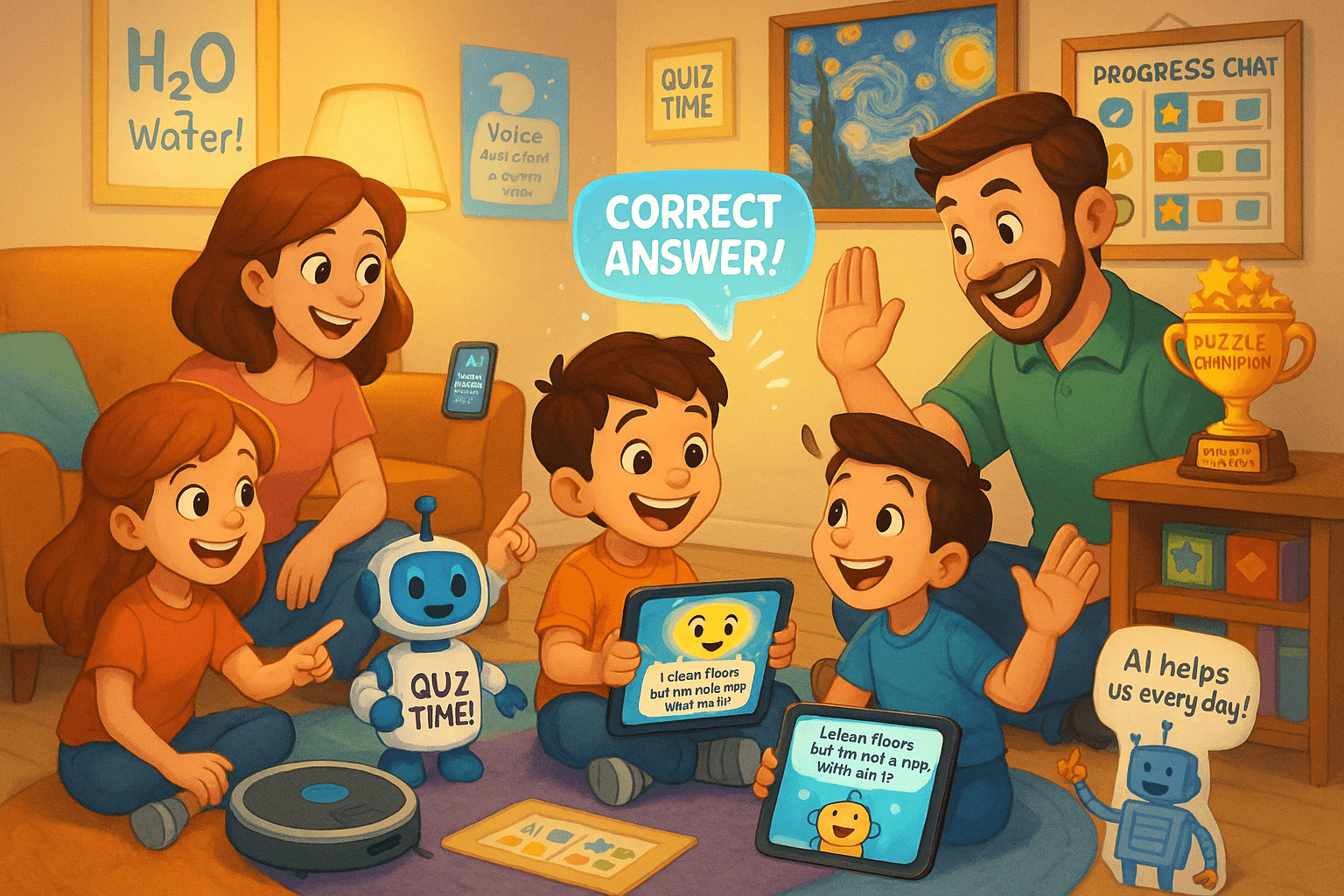Challenging AI-Themed Brain Teasers Every Young Mind Should Try
Challenging AI-Themed Brain Teasers Every Young Mind Should Try
Artificial intelligence (AI) might sound complex, but children can explore it early through fun puzzles and games. It helps build AI thinking skills for children in a natural way. When kids solve these challenges, they learn step-by-step thinking like AI systems. Research shows that puzzles help kids see patterns, like guessing how fast the cheetah runs. They also encourage finding solutions, which boosts problem-solving skills.
These activities make tricky concepts like algorithms simple, while also introducing ethical considerations in technology . Children while playing, ask questions about robots, computers, and collaborate with friends in groups. The key is to keep entertainment value high, which is an important thing in education. This means avoiding school pressure and sparking interest about new technology. This method builds future skills and also removes the fear of technology.
This blog brings together clever artificial intelligence quiz for kids questions, AI riddles for children, trivia questions, tricky riddles and mind-bending challenges designed to boost critical thinking and spark curiosity about AI among young learners.
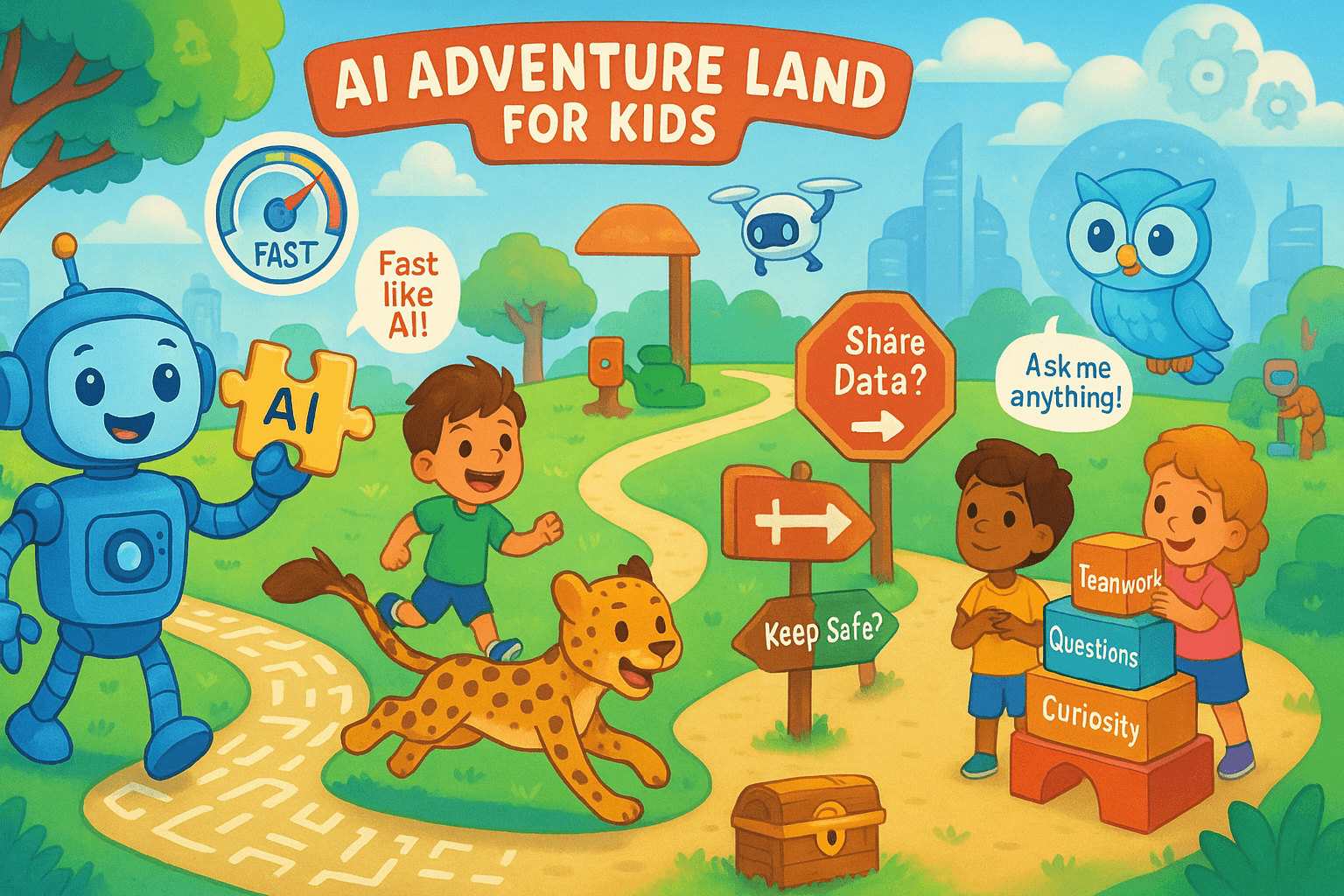
Introduction
AI isn’t just about coding robots or developing apps, it’s about learning to think logically and solve problems creatively.
Kids use AI tools on tablets to solve interactive puzzles. They enjoy learning in fun, hands-on ways. Touch-screen activities help teach basic ideas, like prediction models. For example, will this city have traffic jams?
AI riddles for kids let them see everyday tech in a new light. They can question voice assistants or enjoy quiz apps with drag-and-drop features. These games build knowledge about AI while developing AI thinking skills for children. Puzzles focus on rule-following (like robot instructions), pattern-spotting (similar to identifying chemical symbols), and prediction tasks.
Taking an artificial intelligence quiz for kids helps them train their brains, just like computers think. Finding answers boosts confidence. Each try helps kids improve their critical thinking skills. This foundation prepares them for a world where human intelligence collaborates with AI generated content responsibly.
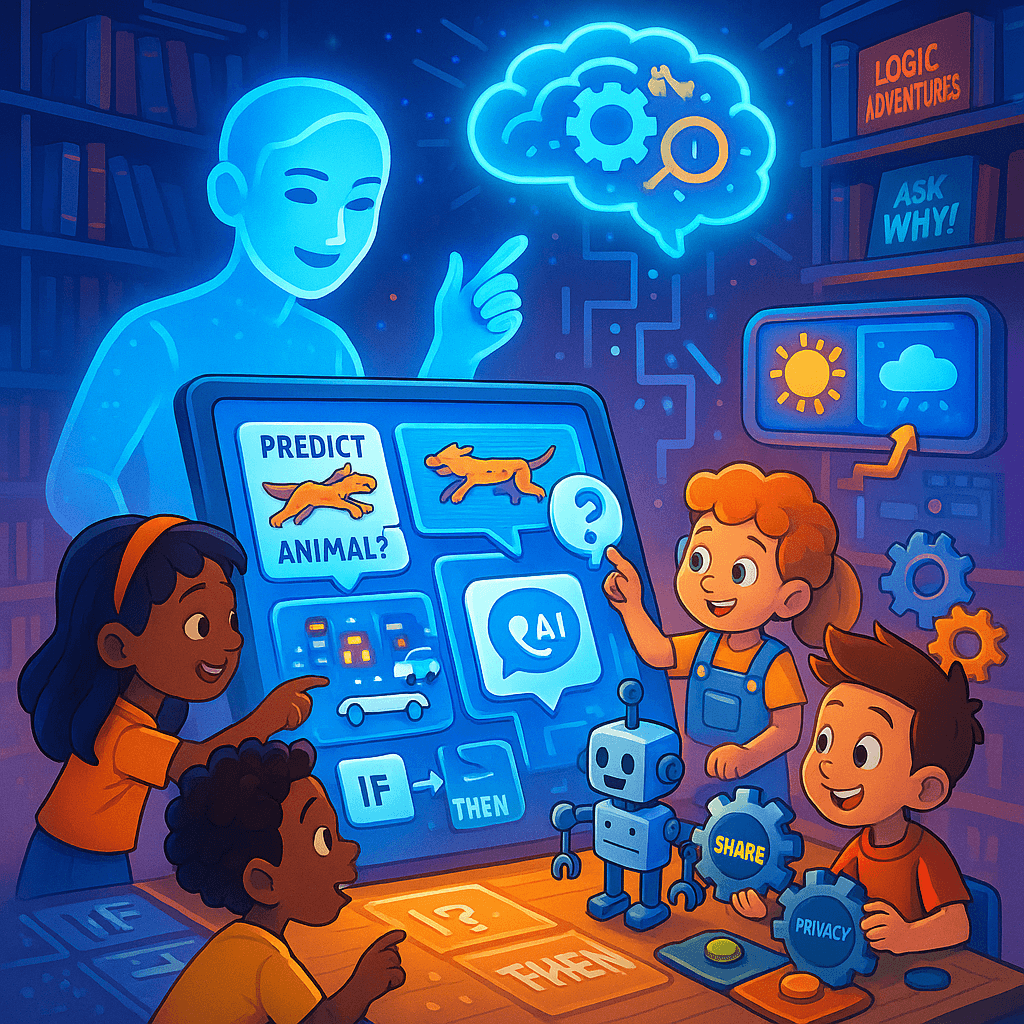
What Makes AI Brain Teasers Different from Regular Puzzles?
AI-themed teasers are different from traditional puzzles. They focus on logic, prediction, patterns, and automation. These skills are key to artificial intelligence. The main goal is to make learning fun.
AI brain teasers blend logic and patterns with new technology themes. Instead of asking about the human body or capital cities, it shows colored blocks. It might ask, What comes next? Kids learn to spot sequences by playing. It's like guessing what a football team will do next or figuring out the size of South America.
This educational approach builds AI thinking skills for children by teaching systematic problem-solving—like creating simple algorithms that have real-world applications. Young minds explore ideas through experiments, and even AI riddles for children become tools for deeper understanding.
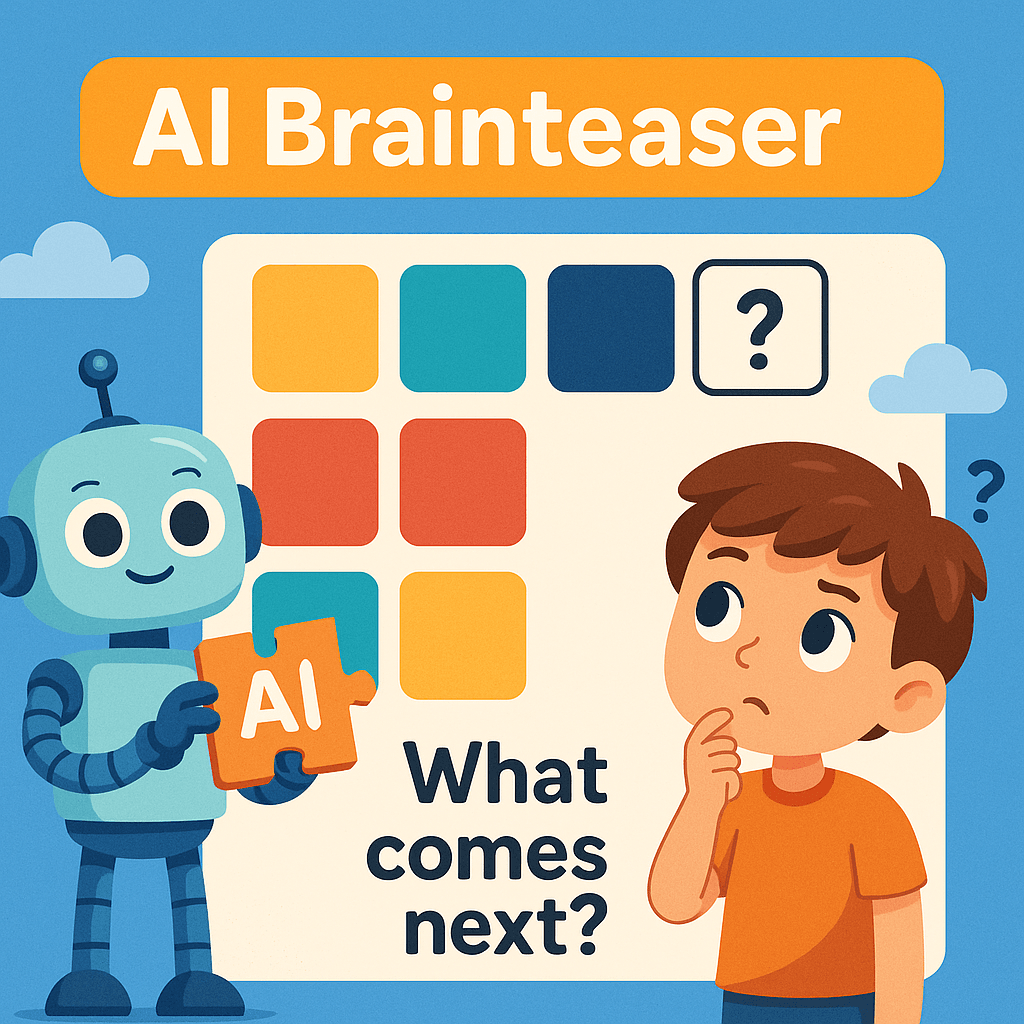
For example, arranging shapes to form the chemical symbol for water mirrors how computers process information AI uses. This develops critical thinking skills naturally through fun challenges.
These puzzles teach children to spot trends like repeated shapes or number sequences. A study found that kids who solve pattern puzzles get better at predicting. This skill is key in artificial intelligence. When a sequence shows A, B, C, A, B, ___, children deduce "C" just like AI tools forecast weather or sport outcomes. Research reveals that kids distinguish human intelligence from machine logic through these activities.
One child said, A computer uses internet data, but our brains create stories.
This highlights key ethical differences between human creativity and AI content.
AI riddles for children help build critical thinking skills. They make robot logic simple and familiar. With instant answers and explanations, kids gain confidence for life in our tech-driven world. These skills get them ready for space exploration, war prevention, no matter what careers they choose.
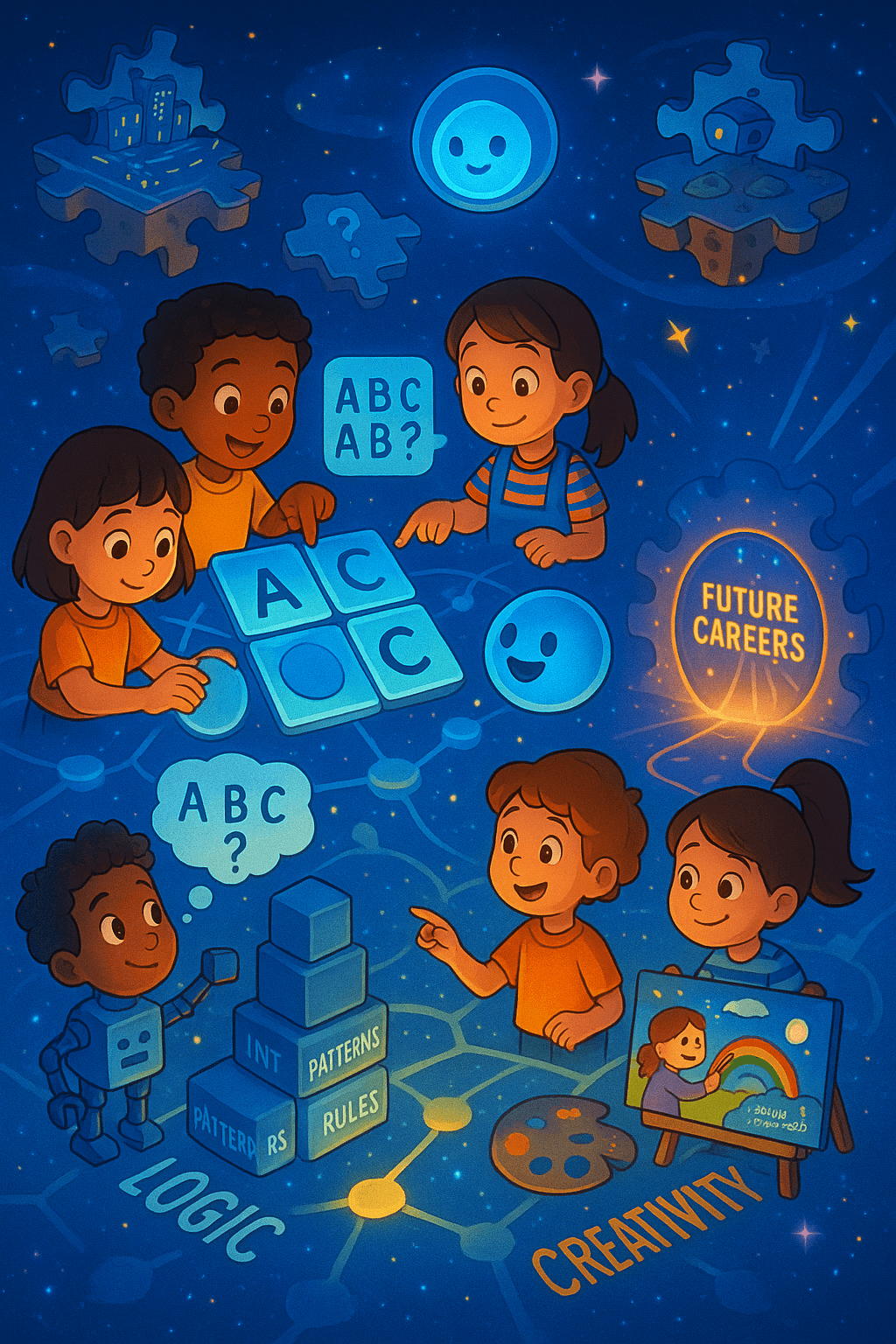
Easy AI Riddles for Children to Get Started
Young kids can have fun with simple AI riddles for children. These riddles use familiar words and everyday experiences to teach core ideas.
For example: "I'm not a person, but I talk with you. I learn from what you say. Who am I?" (Answer: A chatbot). This teaches kids how ai systems communicate, much like the capital cities of different countries.
"I'm a voice in your phone. Say 'Hey' and I find answers or play music. Who am I?" (Answer: Digital assistant). These fun puzzles explain AI through entertainment.
For geography, try this: "I'm the smallest country, as small as a city. What country am I?" (Answer: Vatican City). This trivia makes new technology relatable and builds knowledge.
I clean floors with wheels. I follow commands from an app. What am I?" (Answer: Robot vacuum) Or "What ability lets AI tools distinguish cats from dogs after seeing images?" (Answer: Machine learning). Parents and teachers should praise every attempt of the kid - "Great, You're thinking like an AI engineer" - connecting puzzles to school education.
A study shows this play boosts confidence for tough quizzes and answers later. Track progress with a scoring system to motivate children. As they learn these basics, kids turn into curious explorers. They get ready for space tech or magical AI like in Harry Potter.
Hard Quizzes and Answers That Test Sharp Thinking
As children grow, hard quizzes and answers evolve to challenge their developing skills. Kids with 10year old and above, we test AI thinking skills for children with tricky scenarios. One example is grid pattern analysis. These lights represent capital cities: London (Great Britain)
Which city completes the sequence based on land area? These puzzles need kids to think in steps. They help kids use what they learn in school and science.
Another advanced quiz: "Five robot models line up: red left of blue, green at right end. Who's middle?" These fun problems help kids think critically. They write answers or choose options. They learn from their attempts and the feedback they get.
Introduce ethical questions with an AI quiz for kids. Here’s a dilemma: A self-driving school bus must decide. Should it swerve, risking passengers, or hit obstacles? What ethical considerations guide its programming? This reflects real-world choices in war zones, such as during world wars or space missions. Data literacy questions help build knowledge.
For example, if you want an AI to identify the largest mammal, the blue whale, or the fastest land animal, the cheetah, what should you show first?" (Answer: Diverse animal images). After each try, explanations help with learning.
This applies to both Harry Potter-style magical AI and Fiction film analysis tech. Father can track scores to turn struggles into confidence, as shown by scientific study. Education grows when play meets purpose. This method gets kids ready for future challenges in sports analytics or AI art inspired by Vincent van Gogh.
Artificial Intelligence Quiz for Kids with Fun Facts
This section features a playful AI quizzes for kids that mixes questions with fascinating trivia, even covering topics like world war, to keep things light and engaging.
One of the most exciting ways to learn is through fun facts and trivia in the quiz. An AI quiz for kids can have fun general knowledge questions. These questions can amaze kids and make them exclaim, “Wow, I didn’t know that!”
You can ask a science question like, “What is the largest mammal on Earth?” The answer is the blue whale.
Ask question like “What is the fastest land animal?” (Answer: the cheetah). These questions teach facts while the child is in a quiz mode.
Geography and history can appear too. A question could be “Which is the smallest country by land area?” (Answer: Vatican City).
You could ask “What is the capital city of Great Britain?” (Answer: London).
In art or entertainment, one might ask “Who painted Starry Night?” (Answer: Vincent van Gogh).
For literature, “Which famous wizard goes to a school called Hogwarts?” (Answer: Harry Potter). Even pop culture can appear: “Is Pulp Fiction a book or a movie?” (Answer: a movie). These mix with AI-themed questions to keep the quiz light and fun.
These questions cover a wide range of subjects, including science, history, sports, and art, so kids get a little of everything. Kids who love science learn that Charles Darwin created the theory of evolution. They also find out that water's chemical symbol is H₂O.
For space, a quiz might ask, "Which planet is known as the Red Planet?" (Answer: Mars).
Mixing all these trivia questions with AI topics makes the quiz engaging like a game show. Kids have to think of answers they’ve learned in school (“country, capital, body, sport”), plus use logic from AI riddles. They often work in teams or pairs to guess answers, building group skills. Finding the right answer to a fun question makes them feel proud.
That good feeling also boosts their performance on the AI parts of the quiz. This approach rewards general knowledge and curiosity as much as it rewards understanding AI concepts.
How AI Brain Teasers Help Build AI Thinking Skills in Children
AI brain teasers do more than entertainment. They help young minds grow by encouraging persistence and pattern analysis. Kids approach puzzles like scientists. They make guesses, like “The next block must be yellow”. Then, they test these ideas. When they get it wrong, they learn from it.
This process mirrors algorithm development in programming. Think about this sequence puzzle: "Sun, Mon, Tue, ___". It asks kids to spot the weekday pattern. This skill is important for developing AI thinking. Children face challenges, which helps them build persistence and algorithmic thinking. They learn that problems can lead to growth.
One parent said, "My child stopped being afraid of mistakes after robot coding puzzles
These activities show that learning can be fun and help kids face future tech challenges.
Critical thinking skills grow as children understand cause-and-effect. Placing puzzle pieces teaches decision-making. Wrong choices create roadblocks, while logical steps lead to success. Kids compare human intelligence to AI during group activities.
A child once said, "The computer uses internet data, but humans create original stories
This idea helps kids find mistakes in AI content about the human body or space. These skills apply to school subjects too. They predict chemical reactions by recognizing patterns in symbols. They analyze sports strategies and understand Charles Darwin's theories through data. With each quiz win, kids gain confidence.
Tips for Parents and Educators to Make AI Learning Fun Through Puzzles
Point out AI in daily life: When you use a voice assistant or search engine, mention it to your child. For example, ask your smart speaker a riddle or question, and let them hear the answer. This shows kids that AI tools are just a part of life.
Use AI-themed games and apps: Try board games or apps about coding and robots. There are puzzle apps for kids that talk about space, animals, or puzzles with robot characters. These let children play while learning about technology.
Make it a fun contest: Turn puzzle time into a friendly competition. You could have a family or classroom quiz game, where everyone tries to solve riddles and get points. Kids love working in groups or teams, and a little scoreboard can make it exciting.
Encourage creativity and effort: When a child answers, focus on their reasoning, not just whether it was right. Praise them for trying different ideas, and treat mistakes as learning. For example, say “Great attempt” or “Well done” even if they didn’t solve it immediately.
Teachers can also connect puzzles to kids’ interests. If a child likes sports, include a puzzle about a football or an athlete. If they love stories, include something with characters. Relating puzzles to their world makes the learning stick. It’s also good to explain things simply: use normal words like robot, pattern, and play.
When children see puzzles as entertainment and work with them as a team, they feel supported. This helps them not be afraid of tricky questions and eager to attempt even harder puzzles later.
AI Quiz For Kids – FAQs
What is an artificial intelligence quiz for kids and how is it different from regular quizzes?
AI-themed brain teasers are like a fun artificial intelligence quiz for kids. They make learning fun with puzzles and riddles. These activities increases curiosity among kids about robots and science, similar to how the first woman in science inspired many. A study found that kids liked solving colorful pattern puzzles. They felt proud when even “super-smart” computers couldn’t solve them.
This proves children love these challenges. These quizzes help kids build their AI thinking and critical thinking skills. Studies show that play-based learning helps kids think critically. Games like these also make them more independent. These brain teaser quizzes make learning fun for kids.
How can AI riddles for children improve critical thinking?
AI riddles for children encourage kids to develop deeper thinking skills. Solving these riddles helps children practice logical reasoning. This is like how scientists, such as Charles Darwin, asked questions to discover new ideas. Each riddle is a little challenge: kids use what they know, find clues and figure out answers on their own.
Kids guess, test ideas and find solutions on their own. They learn that solving problems can be fun and educational. They feel proud when they score well or share answers.
At what age can children start solving AI-themed riddles or brain teasers?
Kids can start solving easy AI-themed riddles or brain teasers when they can read a bit, usually at age 6 or 7. In primary school, kids learn to read and solve puzzles. An artificial intelligence quiz for kids with pictures or simple words can be fun for them.
As kids play and practice, their confidence grows and they learn more. By age 8 or 9, many children can handle longer brain teasers or small hard quizzes and answers and keep track of their scores. The key is to keep learning fun, so they play games and solve questions together at home.
What types of questions are included in an AI thinking skills quiz for children?
AI thinking skills for children can include many fun questions. Kids could solve puzzles like spotting patterns, choosing the right robot picture, or tackling simple math and word riddles. Other questions may test general knowledge to keep things fun. For example, you could name an animal or a well-known scientist like Charles Darwin.
Each question has clear answers and kids might earn points or see a score when they finish the quiz. Kids solve problems by guessing the best answers. They also discover new facts about technology and science.
Can AI brain teasers be used in school competitions or group activities?
AI brain teasers work great for school competitions and group activities. Parents and teachers can make the puzzles a fun contest. Kids can form teams to solve riddles about robots or technology. In a group game, kids share answers and cheer when their team solves it first.
Keeping score makes it fun, as each solved puzzle could earn a point. Group play makes learning social and fun. It also builds teamwork and critical thinking. Kids love to show what they know in quizzes. A little competition makes learning fun for everyone.
How can parents encourage interest in AI using riddles and puzzles?
Parents can spark their child’s interest in AI by turning riddles and puzzles into fun family games. They can create an “AI quiz for kids” using toys or apps. These could feature friendly robots. Playing these AI puzzles together helps kids to learn. When kids guess the answers, parent can praise them or give a small reward.
This makes the experience fun and exciting. If a child feels shy or scared of big ideas, either father or mother can start small. They can use everyday examples, like a robot vacuum or a smartphone. Solving fun AI riddles for children and hard quizzes and answers helps kids learn more. It also encourages them to engage in play and find enjoyment in science and technology.
